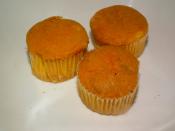What is the History behind Cupcakes?
If you were to walk along the buzzing streets of Times Square, it would not be long before you passed a cupcake shop. These pastries of petite proportions have a winding road of history. They have gone from a common "quickie" at children's birthday parties to being labeled sophisticated, whimsical, and down-right adorable. This confectionary wonder that can fit in the palm of your hand is impacting society with flying colors and leaving only sprinkles behind.
Believe it or not, ancient Egyptians have been found to be the first advanced bakers. The earliest ancestor of the cupcake was a bread-like cake sweetened with honey, and speckled with nuts and dried fruits. In the thirteenth century, cakes spread to Europe in the form of gingerbread and fruitcakes, along with the word cake; taken from the Norse word "kaka."
The more modern style of cake, a circular shape adorned in frosting, blossomed in seventeenth century Europe, due to more reliable ovens, manufacture, ingredient availability, and the arrival of cake hoops and pans.
Although, when this mentions icing, one might envision a delicate, fluffy, creamy lathering mounted on a cake. The norm at the time was a boiled mixture of sugar, egg whites, and the occasional flavor, poured over a cake, which would then come out as a firm, glossy coating. Two hundred years later, in the nineteenth century, cakes obtained their more recent content such as baking soda and other ingredients.
In the mid nineteenth century, the cupcake was born; cup cakes, that is. Before cupcakes came into existence, ingredients were measured by weight; a pound of butter, two pounds of flour, a pound of sugar, etc. This was the origin of the term pound cake. But then ingredients began being measured in cups,


